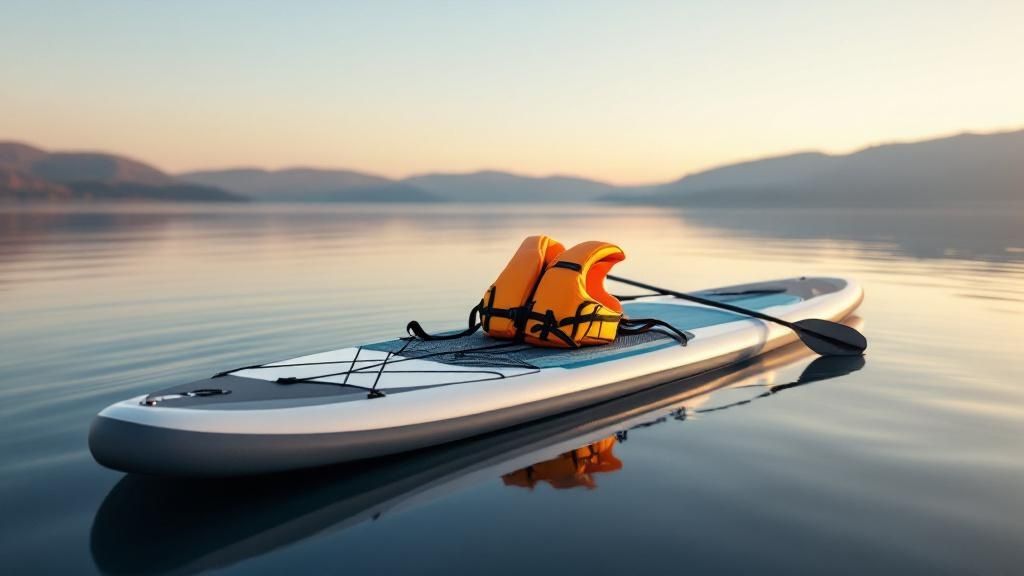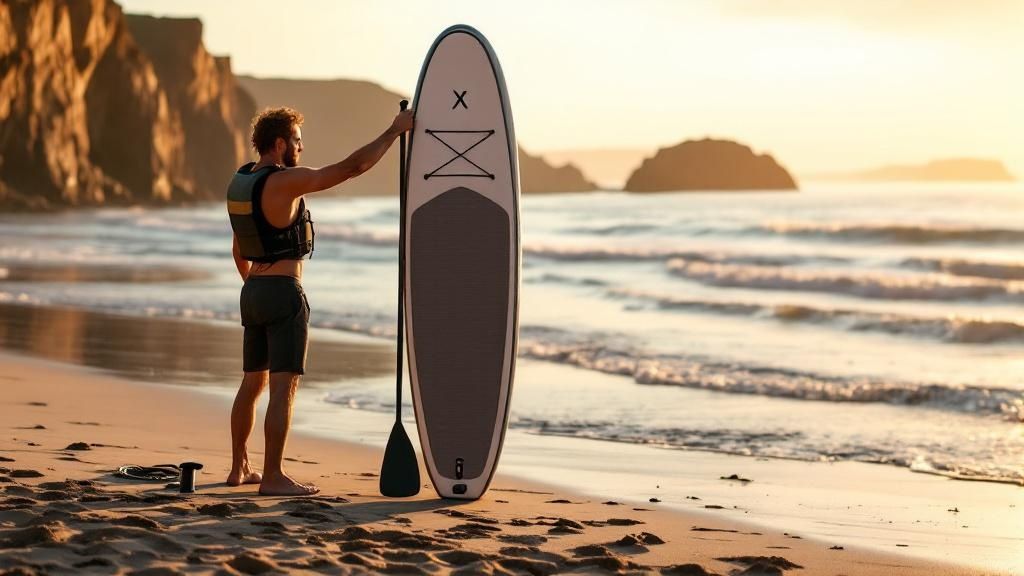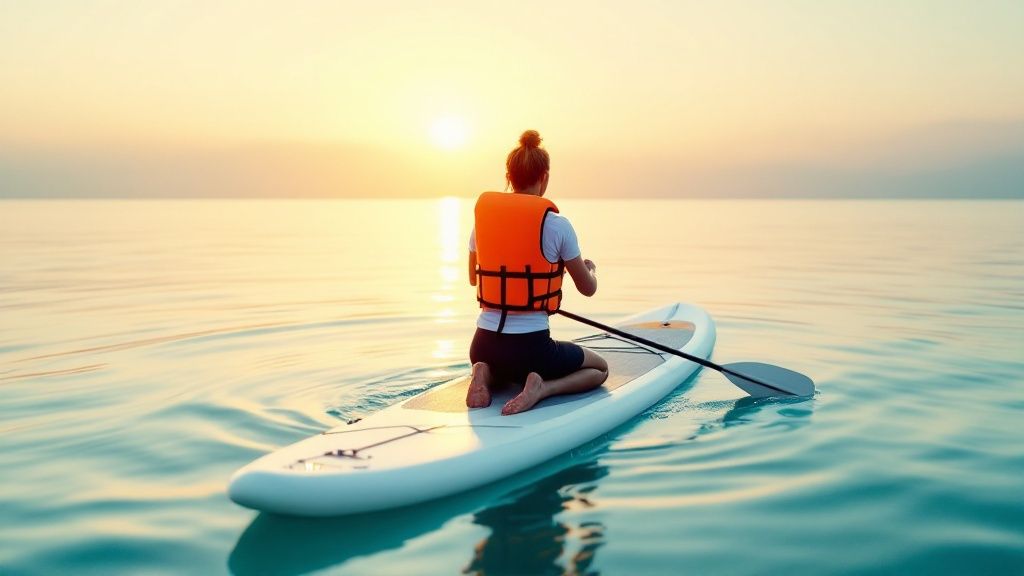Choosing Your Paddle Board Flotation Device
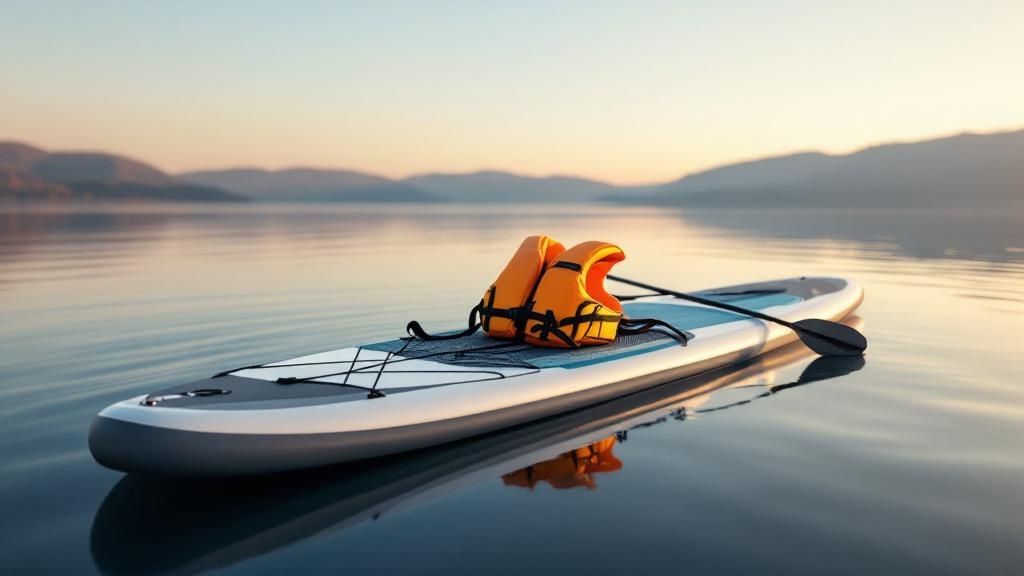
Think of a paddle board flotation device as your seatbelt for the water. You hope you never have to use it, but if something goes wrong, it’s absolutely essential. Your main options boil down to a traditional buoyancy aid vest, which gives you flotation the second you hit the water, or a more minimalist inflatable Personal Flotation Device (PFD) that you deploy when needed. Getting this choice right is fundamental to staying safe every time you head out.
Understanding Your Paddle Board Flotation Device Options
Your flotation device isn't just an accessory; it's a core piece of your kit, as vital as your board and paddle. Its job is simple but critical: keep you afloat if you end up in the water unexpectedly. This isn't just for beginners or weak swimmers either. Even the strongest swimmer can be caught out by cold water shock, a sudden current, or an injury.
As paddle boarding has exploded in popularity across the UK, there's been a much-needed focus on safety. This shift is clear in market trends, too. The global demand for personal flotation devices is projected to jump from USD 6.2 billion in 2024 to over USD 9.1 billion by 2033, pushed by new safety rules and the boom in water sports.
The Two Main Choices for Paddlers
For most stand-up paddle boarders, the decision comes down to two main types of device. Each one is designed for different situations and paddling styles.
- Buoyancy Aid Vests: These are what most people imagine when they think of a life jacket—a wearable vest packed with built-in foam. For example, a family paddling on a local canal would benefit from everyone wearing a simple 50N vest. They provide instant buoyancy and are a fantastic choice for beginners, families, or anyone paddling in chillier or rougher waters. The range of Loco Surfing buoyancy aids are designed for comfort and movement.
- Inflatable PFDs: Usually worn as a discreet waist pack or collar, these devices inflate when you pull a cord, which triggers a small CO2 canister. They offer total freedom of movement, making them a popular choice for racers and experienced paddlers on calm, flat water. For instance, a SUP racer competing on a calm lake will prefer a waist pack PFD to avoid restricting their paddle stroke.
The concept map below breaks down how these device types relate to buoyancy levels and their most common uses.
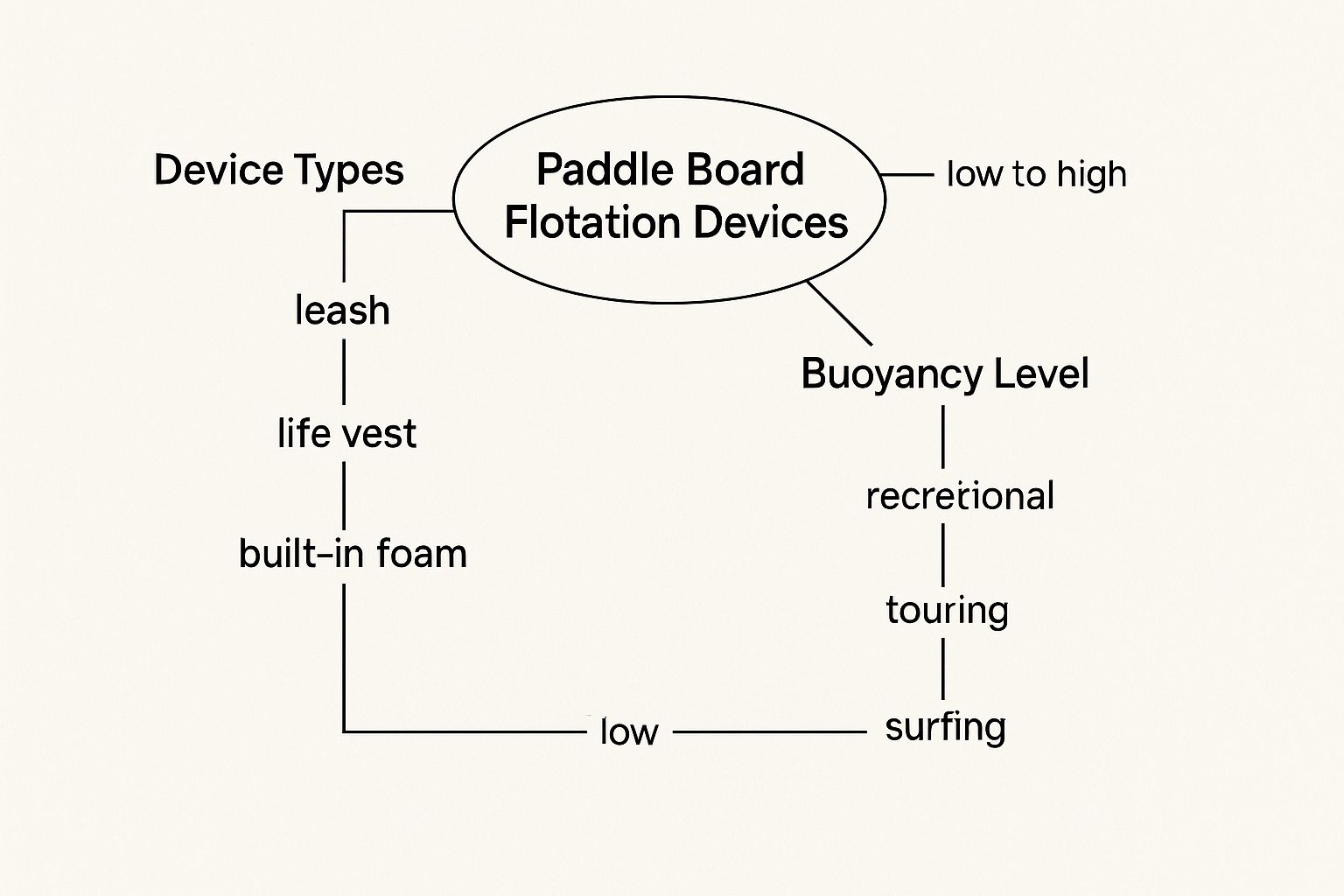
As you can see, your choice of flotation device is tied directly to what you're doing, whether it's a casual paddle with the family or a more serious tour or surf session.
Quick Comparison of Paddle Board Flotation Devices
To help you decide at a glance, we've put together a quick comparison of the two main types of PFDs for paddleboarding. This table breaks down the key features to help you make a fast, informed choice that suits your paddling style.
| Feature | Buoyancy Aid (Vest) | Inflatable PFD (Waist Pack) |
|---|---|---|
| Buoyancy | Instant and constant | Needs manual or automatic inflation |
| Freedom of Movement | Can be slightly restrictive | Maximum freedom, feels like you're wearing nothing |
| Best For | Beginners, families, cold or rough water | Experienced paddlers, racers, calm conditions |
| Maintenance | Low – just rinse and dry | Higher – requires regular checks of the CO2 canister |
| Peace of Mind | High – it’s always ready to work | Requires user action to deploy in an emergency |
Ultimately, the best PFD is the one you'll actually wear. Both options are great, but they serve different needs. Consider your comfort, the conditions you paddle in, and your experience level when making your final decision.
Practical Scenarios and Making a Choice
Let's put this into practice. Imagine you're out for a paddle on a calm, sheltered lake with your family on a Loco Amigo board. A comfortable, well-fitting buoyancy aid vest gives everyone constant peace of mind. Now, picture yourself on a long-distance coastal tour on a breezy day. An experienced paddler might prefer the unrestricted movement of an inflatable waist-pack PFD to keep their paddle stroke efficient.
Your choice should always match your environment and your skill level. For a deeper dive into what to look for, check out our guide on buoyancy aids for SUP. Here at Loco Surfing, we believe the right safety gear gives you the confidence to push your limits, which is why we offer a curated range of essential equipment to keep you safe out there.
Why a PFD Is a Must-Have for Every UK Paddler
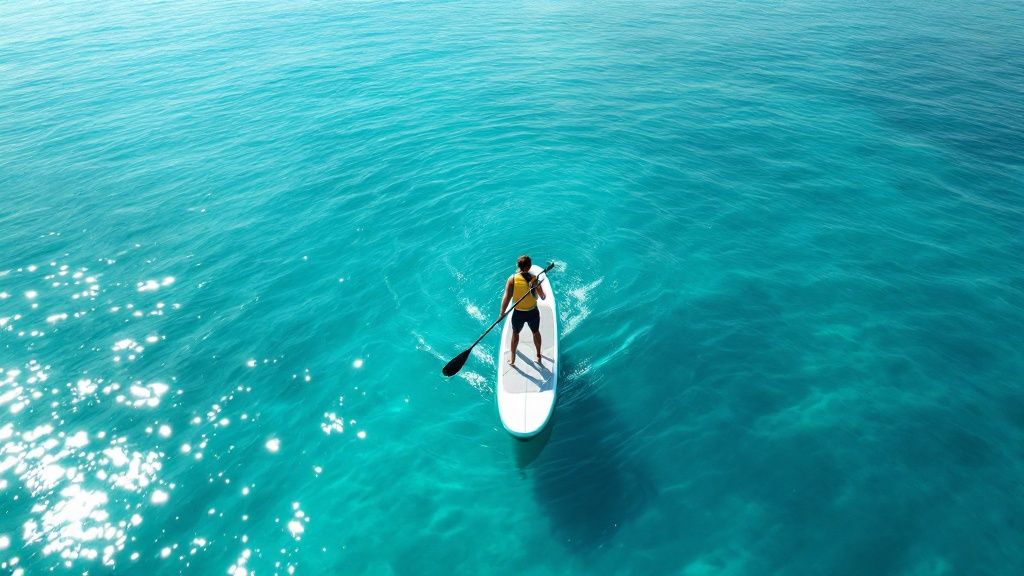
It’s easy to get a false sense of security on a calm, sunny day, gliding across glassy water. But UK waters can be incredibly deceptive, and conditions can turn on a sixpence. A paddle board flotation device isn't just for battling choppy seas; it's a non-negotiable piece of kit for every single outing. It’s there to protect you when the unexpected happens.
The biggest threat often isn’t the waves, but the cold. Any water below 15°C can trigger cold water shock—a powerful, involuntary gasp reflex that can cause you to inhale water. It can catch anyone off guard, no matter how fit you are or how well you can swim, making a reliable flotation device absolutely essential.
The Sobering Reality of UK Water Safety
Despite the obvious dangers, a shocking number of paddlers still head out without a PFD. A 2022 survey found that a staggering 62% of UK paddlers and other watersport enthusiasts admitted to not wearing one. This risky behaviour has put a huge strain on rescue services. In fact, RNLI data shows that 75% of their paddle sport rescues in the last decade have happened since 2020.
These aren't just numbers on a page; they represent real people finding themselves in serious trouble. The simple act of wearing a paddle board flotation device is the single most effective way to stop a small mistake from spiralling into a life-threatening emergency.
As a practical example, picture this: a regular paddler, Alex, is enjoying a coastal tour when a sudden offshore gust flips him into the water. The shock of the cold instantly takes his breath away, but his buoyancy aid keeps his head clear of the surface. It gives him the vital seconds he needs to get his breathing under control, climb back on his board, and paddle safely back to shore.
Let's Bust Some Common Myths
We’ve all heard the excuses for ditching the PFD, but when you look at the facts, they just don't hold water. Let's tackle the most common ones we hear.
- "But I'm a strong swimmer." Your swimming prowess means very little when cold water shock hits, you're caught in a sudden current, or you get separated from your board. A PFD is there to support you when you physically can't support yourself.
- "It's just too bulky and gets in the way." Modern PFDs are a million miles away from the clumsy, old-school life jackets you might be imagining. Brands like Loco Surfing design sleek, ergonomic buoyancy aids specifically for paddle boarding, offering a full range of motion. You’ll barely even notice you're wearing it.
- "The weather is perfect, I won't need it." Conditions can change in a flash. A calm sea can get choppy in minutes, and an unexpected fall can happen to anyone, at any time.
Making your PFD a standard part of your gear is a simple habit that could genuinely save your life. For more practical advice on staying safe out there, check out our essential paddleboarding safety tips to make sure you're ready for anything.
Getting to Grips with UK Laws for Paddle Board Flotation Devices
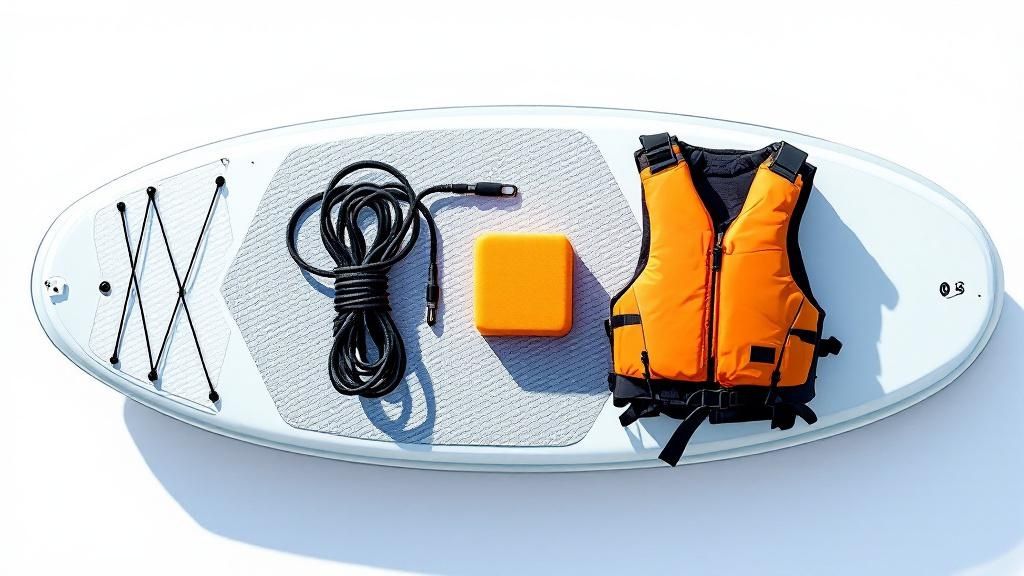
Let's clear the water on the legal side of using a paddle board flotation device in the UK. The truth is, it can feel a bit murky. There isn't one single, sweeping law that says every private paddler must wear one, no matter what.
But that definitely doesn't mean you can just ditch it. The rules are a patchwork, changing depending on where you decide to launch your board. Your responsibility for safety is shaped by local byelaws and the specific authorities managing the waterway. Think of it like speed limits on the road – what’s fine on a quiet country lane is completely different on a motorway.
Where You Paddle Sets the Rules
Various organisations govern the UK’s waters, and many have their own strict safety requirements you need to follow. It’s always on you, the paddler, to check the local rules before you even think about getting on the water.
Here’s a look at who calls the shots in different places:
- Canals and Rivers: The Canal & River Trust, which looks after most of the inland waterways in England and Wales, strongly advises wearing a PFD. Some river authorities are even tougher; the Port of London Authority, for instance, has very specific rules for the Thames. For example, on certain busy stretches of the Thames, wearing a PFD is mandatory, not just advisory.
- Coastal Waters: Out on the coast, you're under the eye of local harbour masters and maritime authorities. They often make PFDs mandatory in their patch, especially in busy shipping lanes or around mooring areas where there's lots of boat traffic.
- Managed Lakes and Reservoirs: If you're heading to a managed lake or reservoir that's set up for watersports, you'll almost certainly be required to wear a buoyancy aid. It's usually a non-negotiable part of their site safety policy just to get access.
Understanding Safety Labels and Standards
When you're shopping for a paddle board flotation device, you’ll see labels covered in acronyms and numbers. These aren’t just for decoration; they’re your guarantee that the gear has passed serious safety tests. For UK paddlers, the key marks to look out for are the UKCA or the older CE mark.
These markings are a crucial stamp of approval, confirming the device has been tested to perform reliably when you might need it most. They’re a clear sign of a quality, trustworthy product.
The number you'll often see next to these marks is ISO 12402. This is the international standard for personal flotation devices, and it classifies them based on their level of buoyancy. This system makes sure you can pick the right gear for the right activity. For a deeper dive into what separates a good PFD from a great one, check out our expert advice on choosing a paddle board life jacket. At Loco Surfing, we only stock safety gear that meets these high standards, so you can hit the water with total confidence.
How to Choose the Right PFD for Your Paddling Style
Picking the right paddle board flotation device isn't a simple case of grabbing the first one you see. The best PFD for you is the one that fits what you’re doing, the board you’re on, and the water you’re exploring. It’s a bit like choosing shoes – you wouldn’t wear hiking boots for a stroll on the beach, and the same thinking applies to your safety gear.
Your paddling style really dictates what you need. Someone having a relaxed float around a calm lake has completely different needs to a competitive racer or a long-distance tourer. Getting this choice right means you'll have that perfect sweet spot of safety, comfort, and performance every single time you head out.
Matching a PFD to Your SUP Adventure
To find your perfect PFD, have a think about what you actually do on your board most of the time. Different activities call for different levels of movement, storage options, and buoyancy.
-
Leisurely Paddles and All-Round Fun: If your perfect day involves a gentle paddle on a calm lake with a board like the versatile Loco Amigo, then comfort is your number one priority. A simple 50N buoyancy aid vest is spot on. It gives you reliable flotation without feeling bulky or restrictive, leaving you free to enjoy a relaxed day out.
-
SUP Surfing and Racing: For high-octane stuff like catching waves or sprinting in a race, freedom of movement is everything. You'll want a low-profile, ergonomic PFD that feels more like a second skin than a piece of safety kit. These vests are specifically designed to allow a full range of arm and torso rotation, so your gear will never hold back your performance.
-
Long-Distance Touring: When you’re clocking up serious miles on a board like the Loco Explorer, your PFD becomes a crucial part of your kit. Look for a touring-specific vest that has pockets for a hydration pack, snacks, and your phone. For example, having a front zip pocket to keep your phone dry and accessible for navigation is a game-changer on a long trip.
To make it even clearer, here’s a quick guide to help you match your PFD to your paddling plans.
Matching Your PFD to Your Paddle Boarding Activity
This table breaks down the essentials, helping you match your primary paddleboarding activity with the most suitable type of PFD and the key features you should be looking for.
| Activity Type | Recommended PFD Type | Key Features to Look For |
|---|---|---|
| All-Round & Leisure | Buoyancy Aid Vest (50N) | Simple, comfortable fit; minimal bulk; high freedom of movement. |
| SUP Surfing & Racing | Low-Profile Performance Vest | Ergonomic cut; deep armholes for full rotation; lightweight materials. |
| Touring & Exploring | Touring Vest with Pockets | Hydration pack compatible; multiple storage pockets; adjustable straps for a secure fit. |
| Yoga & Fitness | Waist Pack PFD (Inflatable) | Unrestricted upper body movement; manual inflation; minimalist design. |
Choosing the right PFD ensures you're not just safe, but also comfortable and equipped for whatever your paddle session throws at you.
Decoding PFD Features
Trying to make sense of the technical jargon on a PFD label can feel a bit much, but you only need to know a couple of key terms to shop like a pro.
The most important one is the Newton (N) rating. This is simply a measure of how much buoyancy the device provides. A 50N device is a buoyancy aid, perfect for keeping a conscious person afloat in sheltered waters where help is nearby. For more demanding conditions, a 100N+ PFD (which is often classed as a lifejacket) offers much more powerful flotation and is designed to help turn you onto your back, keeping your airways clear if you get into trouble.
A proper fit is just as crucial as the N rating. Your PFD should be snug, but not uncomfortably tight. The classic test is to tighten all the straps and then have someone pull up on the shoulders. If it slides up past your ears, it’s too loose and won’t support you properly when you need it most.
Finally, give a thought to the materials. Modern PFDs use advanced, lightweight foams and tough outer fabrics that are quick-drying and feel comfortable against the skin. Investing in a quality PFD from a trusted brand means you’re getting a device that isn’t just safer, but also a whole lot more comfortable to wear all day long.
Here at Loco Surfing, we stock a curated selection of PFDs and safety accessories that have been hand-picked specifically for paddle boarders. By matching these key features to your paddling style, you can find the perfect paddle board flotation device to keep you safe and comfortable on every single adventure.
Maintaining Your PFD for Lasting Safety
A paddle board flotation device is one of those bits of kit you absolutely have to trust. But you can only rely on it if you look after it properly. Just like any crucial safety gear, regular checks and a bit of care are what make sure it’s going to work flawlessly when you really, really need it. Letting your PFD maintenance slide isn’t just a bit careless; it can be incredibly dangerous.
And that’s no exaggeration. Recent safety alerts have flagged some serious quality issues with flotation devices on the UK market. A Royal National Lifeboat Institution (RNLI) survey in the South West uncovered a pretty shocking statistic: out of 803 lifejackets they checked, a staggering 523 (that's around 65%!) had faults that could stop them from working in an emergency. The problems ranged from degraded materials to simply not meeting safety standards, which really hammers home why doing your own checks is so vital. You can get the full story on these findings and current safety alerts from Paddle UK, the national body for paddlesports.
Your Pre-Paddle Inspection Checklist
Make this a habit. Before every single trip out, give your PFD a quick but thorough once-over. It takes less than a minute and is genuinely one of the smartest safety routines you can get into.
- Check Straps and Buckles: Give every strap a good, firm tug to make sure it’s securely stitched in. Click each buckle open and closed. You want to feel a solid click as it fastens and see it release smoothly without getting stuck.
- Examine the Seams and Fabric: Run your eyes over the entire device. You’re looking for any signs of wear and tear—rips, frayed stitching, or even faded, brittle-looking material. UV light and saltwater are the biggest enemies of the fabric, so pay extra attention to the areas that get the most sun.
- Test Buoyancy (for traditional vests): If you've got a classic foam vest, especially an older one, you can easily test its buoyancy in shallow water. It should hold you up comfortably without you needing to tread water. If it feels a bit waterlogged or just doesn’t seem as buoyant as it used to, it’s time for a replacement.
Specific Checks for Inflatable PFDs
Inflatable PFDs need a little more attention because of their moving parts. These checks aren't optional—they're essential to be sure your inflatable paddle board flotation device will actually inflate when you need it to.
- CO2 Cylinder Check: Unscrew the CO2 cylinder and have a good look. It should be totally free from rust or any dings, and the little indicator on the inflation mechanism should be green. Green means go. If it’s showing red, it’s been fired or is faulty, and you need to fit a new cylinder before you go anywhere.
- Oral Inflation Test: Find the oral inflation tube and blow into it until the bladder is firm. Now, leave it inflated overnight somewhere you’ll see it. If it’s lost any air by the morning, you’ve got a slow leak. It shouldn't be used until it's been professionally repaired or replaced.
As a practical example, always remember to properly deflate and repack your inflatable PFD exactly as the manufacturer shows you after doing an inflation test. A badly packed device might not inflate correctly in an emergency, which defeats the whole point.
Proper cleaning and storage are just as important as the checks. After every use (especially in saltwater), give your PFD a thorough rinse with fresh water. Then, let it air dry completely in a shady, well-ventilated spot before you pack it away. This simple step stops mould, mildew, and fabric rot in its tracks, massively extending the life and reliability of your gear.
Putting Safety First on Every Paddle
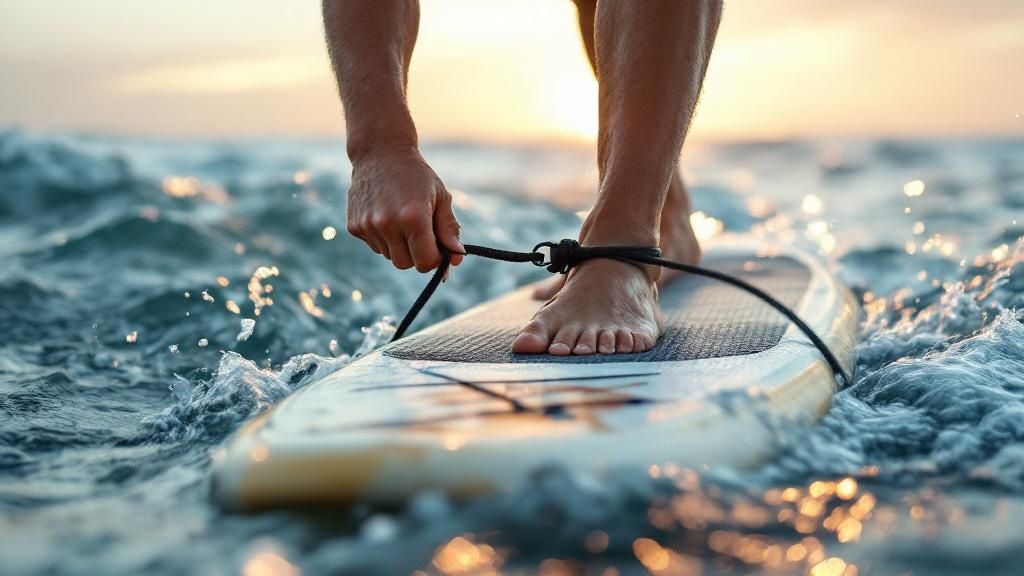
Every great adventure on the water starts and ends with one thing: safety. It's easy to get caught up in the excitement, but choosing and always wearing the right paddle board flotation device is the single most important call you can make before your board even touches the water. Think of it as your silent partner, your reliable backup for when things don't go to plan.
We've walked through the key bits to keep you safe and paddling with confidence. From telling the difference between a buoyancy aid and a full-on inflatable PFD, to understanding the very real risks in UK waters like cold water shock, it’s all about being prepared. You know now that your gear needs to match your ambition—a lazy Sunday paddle calls for a different PFD than an all-day coastal tour.
Remember, a well-maintained PFD is a lifesaver. Your pre-paddle checks are just as crucial as your paddle stroke technique.
So, before you head out again, put safety at the top of your list. It's worth investing in a quality PFD that fits you properly and is right for the kind of paddling you love. For a premium selection of boards and safety gear, check out Loco Surfing. We're here to make sure you have an amazing and secure time on the water. Make every paddle a safe one.
Still Got Questions?
Even after wading through all the details, you might have a few lingering questions about picking the right flotation device for your paddle board. That's perfectly normal. Let's tackle some of the most common ones we hear from fellow paddlers.
Are Kids' Flotation Devices Just Smaller Versions of Adult Ones?
Not at all, and it's a crucial distinction. A child's PFD is engineered specifically for their smaller frame and lower body weight to ensure it keeps their head well above the water in an emergency. You should always, always choose one based on your child's current weight, not their age.
Keep an eye out for key safety features like a sturdy grab handle on the back (a lifesaver for getting them back on the board) and crotch straps. These straps are vital to stop the vest from simply riding up over their head if they fall in. Never be tempted to put a child in an adult-sized PFD; it won't offer the right buoyancy and could be incredibly dangerous.
Are Inflatable PFDs a Good Choice for People Who Can't Swim?
If you're not a confident swimmer, a traditional foam buoyancy aid is without a doubt your safest bet. It's ready to go the second you hit the water, providing instant flotation with zero effort on your part.
Inflatable PFDs, on the other hand, have a slight delay before they're fully buoyant. If you've got a manually operated one, it also relies on you being conscious and calm enough to pull the cord. For that complete peace of mind, a permanently buoyant vest like the ones we stock at Loco Surfing offers immediate, reliable protection every time.
How Can I Be Sure My PFD Fits Properly?
A good fit is everything—a poorly fitted PFD won't do its job when you need it most. Start by putting the device on and tightening all the straps, working your way up from your waist to your shoulders. It should feel snug, but not so tight that you can't breathe easily or move your arms freely for paddling.
Here's the classic test: get a friend to grab the shoulder straps and pull up firmly. If the device slides up past your nose or mouth, it's too loose. A correctly fitted paddle board flotation device should hug your torso and stay put, no matter what.
Ready to paddle with confidence? The best adventures start with the right safety gear. Loco Surfing offers a premium selection of high-quality PFDs and essential accessories designed to keep you safe on every trip. Explore our range and gear up for your next session at https://www.locosurfing.com.


